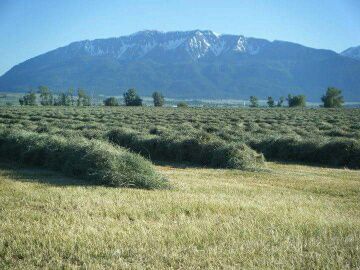De-icer on roads slows hay transport
Published 7:04 am Friday, January 9, 2015

- photo/Myranda McFetridge Windrows of timothy hay on a Wallowa County farm are ready to bale.
It’s not the lack of sales nor icy roads themselves that slow the flow of loaded hay trucks exiting Wallowa County at this point of the winter, but instead the magnesium chloride the Oregon Department of Transportation is applying to make highways and freeways safer to drive on.
As explained by Craig Willis, owner of the biggest trucking firm in Wallowa County, the cost to haul freight rises when ODOT has to salt the roads. And it’s not directly the salt that ups the tab, but instead the added cost of tarping loads of hay to protect them from moisture kicked up by wet, melting roads. “Tarping is very labor intensive,” says Willis. “It takes maybe two hours to tarp a load, and that might add $50 to the cost of freight.”
Trending
Most hay harvested last summer and destined to leave Wallowa County was sold long ago to ready markets, much of it to buyers in the Pacific Rim, specifically Japan, and much to Kentucky, says Jay McFetridge, treasurer of the Wallowa County Hay Growers Association. McFetridge says much of Wallowa County’s prized timothy hay eventually is consumed by race horses at both locations.
Two local growers of timothy hay target their yields to race horses in Kentucky. Dan Butterfield and son Robert Butterfield regularly harvest and ship smaller bales to Kentucky simply because such bales are easier to feed, says McFetridge. The larger bales shipped elsewhere by hay growers here more commonly are purchased by a Boardman-based outlet named Oregon Hay that compresses those bales and prepares them for overseas shipping.
Willis runs a total of 24 trucks, seasonally hauls hay in eight of them, and transports hay year-around in three trucks. He states clearly that it’s not the cold weather that’s cutting back the number of his hay runs now on the road, but instead the economics, or added costs triggered by tarping.
The only president the Wallowa County Hay Growers Association has ever known, Mark Butterfield, estimates that Wallowa County produces twice the volume of export-grade timothy hay as compared to export-grade alfalfa.
In the eyes of McFetridge, the 2014 hay season was above average, yet not a record year.
Timothy hay prices, typically $20 to $30 per ton higher than comparable alfalfa hay prices, are marketing between $220 and $240 a ton this year, significantly below 2013 prices when untimely rains hindered the timothy crop in the competitive Ellensburg, Wash., area, hiking local timothy hay prices to record $230 to $260 levels, McFetridge said.
Trending
Butterfield said the recent emergence of Oregon Hay, in Boardman, has reduced overhead costs such as miles traveled and is diverting business from a similar international hay exporting firm in Ellensburg.









